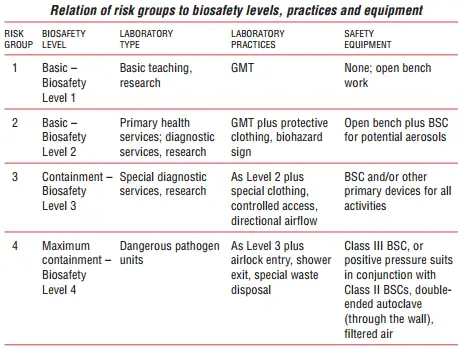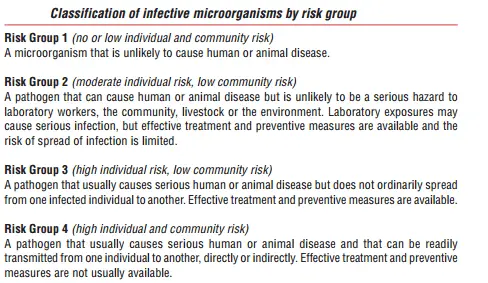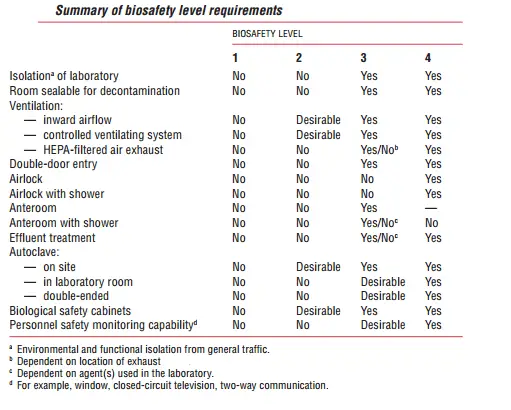Biosafety level 2 (BSL2) guidelines for teaching laboratories
Preamble: Educators need to be aware of the risks inherent in using microorganisms in the laboratory and must use best practices to minimize the risk to themselves, students, and the community.
The following guidelines are designed to encourage awareness of the risks, uniformity in best teaching practices, and safety of the students. These guidelines are not mandatory, but are designed to promote best practices in the teaching laboratory.
Use of organisms that require BSL2 facilities is not recommended for typical K–12 settings unless these facilities are available. BSL2 is suitable for organisms that pose moderate individual risk and low community risk for infection. When good microbiological techniques are used, these organisms rarely cause serious disease, and effective treatment for laboratory-acquired infections is available.
Best practices must be adopted to minimize the risk of laboratory-acquired infections and to train students in the proper handling of organisms that require BSL2 procedures. Students should always demonstrate proficiency in laboratory techniques using organisms that require BSL1 practices before being allowed to handle organisms that require BSL2 practices.
The practices set forth in these guidelines fall into six major categories: personal protection, laboratory physical space, stock cultures, standard laboratory practices, training, and documents. For ease of use, the requirements and practices are brief.
Personal Protection Requirements for Biosafety level 2 (BSL2) teaching laboratories
- Wear safety goggles or safety glasses for normal laboratory procedures involving liquid cultures that do not generate a splash hazard (e.g., proper pipetting, spread plates, etc.). Use safety goggles and face shields or safety goggles and masks when performing procedures that may create a splash hazard. If work is performed in a biological safety cabinet, goggles and face shields/ masks do not need to be worn.
- Wear closed-toe shoes that cover the top of the foot.
- Wear gloves when handling microorganisms or hazardous chemicals.
- Wear laboratory coats.
Laboratory Physical Space Requirements for Biosafety level 2 (BSL2) teaching laboratories
- Require all laboratory space to include:
- Nonporous floor, bench tops, chairs, and stools.
- Sink for hand washing.
- Eyewash station.
- Lockable door to the room.
- Follow proper pest control practices.
- Keep the storage area for personal belongings separate from work area.
- Keep a working and validated autoclave in the building or arrange for licensed waste removal according to local, state, and federal regulations.
- Post biohazard signage
- wherever cultures are used and stored.
- on the door to the room.
- on any containers used to transport cultures.
- Recommended: Have a biological safety cabinet. The biological safety cabinet is required when large volumes of culture are used or when a procedure will create aerosols.
Stock Culture Requirements for Biosafety level 2 (BSL2) teaching laboratories
- Only use cultures from authorized, commercial, or reputable sources (e.g., an academic laboratory or state health department). Maintain documents about stock organisms, sources, and handling of stock cultures.
- Obtain fresh stock cultures of microorganisms annually (e.g., purchased, revived from frozen stock cultures, etc.) to be certain of the source culture, minimize spontaneous mutations, and reduce
- contamination.
- Keep stock cultures in a secure area.
Standard Laboratory Practices for Biosafety level 2 (BSL2) teaching laboratories
- Wash hands after entering and before exiting the laboratory.
- Tie back long hair.
- Do not wear dangling jewelry.
- Disinfect bench before and after the laboratory session with a disinfectant known to kill the organisms handled.
- Use disinfectants according to manufacturer instructions.
- Do not bring food, gum, drinks (including water), or water bottles into the laboratory.
- Do not touch the face, apply cosmetics, adjust contact lenses, or bite nails.
- Do not handle personal items (cosmetics, cell phones, calculators, pens, pencils, etc.) while in the laboratory.
- Do not mouth pipette.
- Label all containers clearly.
- Keep door closed while the laboratory is in session. Laboratory director or instructor approves all personnel entering the laboratory.
- Minimize the use of sharps. Use needles and scalpels according to appropriate guidelines and precautions.
- Use proper transport vessels (test tube racks) for moving cultures in the laboratory and store vessels containing cultures in a leak-proof container when work with them is complete.
- Use leak-proof containers for storage and transport of infectious materials.
- Use microincinerators or disposable loops rather than Bunsen burners.
- Arrange for proper (safe) decontamination and disposal of contaminated material (e.g., in a properly maintained and validated autoclave) or arrange for licensed waste removal according to local, state, and federal regulations.
- Do not handle broken glass with fingers; use a dustpan and broom.
- Notify instructor of all spills or injuries.
- Document all injuries according to university or college policy.
- Keep note-taking and discussion practices separate from work with hazardous or infectious material.
- Use only institution-provided marking pens and writing instruments.
- Teach, practice, and enforce the proper wearing and use of gloves.
- Advise immune-compromised students (including those who are pregnant or may become pregnant) and students living with or caring for an immune-compromised individual to consult physicians to
- determine the appropriate level of participation in the laboratory.
Training Practices for Biosafety level 2 (BSL2) teaching laboratories
- Be aware that student assistants may be employees of the institution and subject to OSHA, state, and/or institutional regulations.
- Conduct extensive initial training for instructors and student assistants to cover the safety hazards of each laboratory. The institution’s biosafety officer or microbiologist in charge of the laboratories should conduct the training.
- Conduct training for instructors whenever a new procedural change is required.
- Conduct training for student assistants annually.
- Require students and instructors to handle microorganisms safely and responsibly.
- Require students to demonstrate competency at BSL1 before working in a BSL2 laboratory.
- Inform students of safety precautions relevant to each exercise before beginning the exercise.
- Emphasize to students the importance of reporting accidental spills and exposures.
Document Practices for Biosafety level 2 (BSL2) teaching laboratories
- Require students to sign safety agreements explaining that they have been informed about safety precautions and the hazardous nature of the organisms they will handle throughout the course.
- Maintain student-signed safety agreements at the institution.
- Prepare, maintain, and post proper signage.
- Document all injuries and spills; follow university policy, if available.
- Make Material Safety Data Sheets (MSDS) available at all times; follow institutional documentation guidelines regarding number of copies, availability via print or electronic form, etc.
- Post emergency procedures and updated contact information in the laboratory.
- Maintain and make available (e.g., in a syllabus, in a laboratory manual, or online) to all students a list of all cultures (and their sources) used in the course.
- Keep a biosafety manual specific to the laboratory and/or course in the laboratory.
- Keep a copy of the current version of Biosafety in Microbiological and Biomedical Laboratories (BMBL) in the laboratory.
Source: Biosafety Guidelines for Handling Microorganisms in the Teaching Laboratory: Development and Rationale by: Elizabeth A. B. Emmert and the ASM Task Committee on Laboratory Biosafety Department of Biological Sciences, Salisbury University, Salisbury. JOURNAL OF MICROBIOLOGY & BIOLOGY EDUCATION, May 2013, p. 78-83
Non culturable Pathogenic Bacteria: Challenge to laboratory diagnosis of disease
Culture is one of the most widely used laboratory diagnostic tool. Culture helps microbiologist for the identification and characterisation of the causative agents of the disease. To perform antimicrobial susceptiblity test also, microbiologist have to grow the bacteria in the laboratory media (though now antimicrobial resistance can be assessed better by Molecular diagnostic tools).
Due to the specific nutritional requirements of bacteria, a single media can not support the growth of all be bacteria so there are various bacteriologic media to help for the growth of specific bacteria. But still there are some bacteria which can not be cultured (or grown) in the bacteriologic media available till date:
- T. pallidum has not yet been grown in bacteriologic media or in cell culture. (But non pathogenic treponemes can be cultured). Diagnosis is made by microscopy and serology.

Nine banded armadillo
- M. leprae has not yet been grown in the laboratory either on artificial media or in cell culture. It can be grown in the mouse footpad or in the armadillo.
- Chlamydia trachomatis It can not be grown in artificial medium but most be grown in living cells. Bacteria that can be cultured: but rarely cultured in standard clinical laboratory
- Coxiella burnetti (causative agent of Q Fever): Risk of Laboratory acquired infections is very high Cultivation of Coxiella burnetti must be done in a bio-safety level 3 containment facility (facility not available in standard clinical laboratory).
- Rickettsia (they are the fastidious bacteria that are obligate, intracellular parasite), and causes Rickettsial pox, Rocky Mountain Spotted fever, Typhus fever: They can be cultured in embroyonated egg or tissue culture, the risk of laboratory acquired infection is extremely high, so culture rarely done.
Biosafety level 1 (BSL1) guidelines for teaching laboratories
Preamble: Educators need to be aware of the risks inherent in using microorganisms in the laboratory and must use best practices to minimize the risk to students and the community. The following guidelines are designed to encourage awareness of the risks, promote uniformity in best teaching practices, and protect the health and wellness of our students.
These guidelines are not mandatory, but are designed to promote best practices in the teaching laboratory. Note that not all institutions are equipped to handle organisms in a BSL2 setting. Work with microbes at the K–12 level, informal education settings (e.g., science fairs, museums, science centers, camps, etc.), and in undergraduate non-microbiology laboratories would almost always be at BSL1.
Even though organisms manipulated in a BSL1 laboratory pose a low level of risk to the community and are unlikely to cause disease in healthy adults, most of the microorganisms used in the microbiology teaching laboratory are capable of causing an infection given the appropriate circumstances. Many best practices should be adopted to minimize the risk of laboratory-acquired infections and to train students in the proper handling of microorganisms.
The practices set forth in these guidelines fall into six major categories: personal protection, laboratory physical space, stock cultures, standard laboratory practices, training, and documents. For ease of use, the requirements and practices are brief. Explanatory notes, sample documents, and additional resources can be found in the appendix.
Personal Protection Requirements in Biosafety level 1 (BSL1) teaching laboratories.
- Wear safety goggles or safety glasses when handling liquid cultures, when performing procedures that may create a splash hazard, or when spread plating.
- Wear closed-toe shoes that cover the top of the foot.
- Wear gloves when the student’s hands have fresh cuts or abrasions, when staining microbes, and when handling hazardous chemicals. Gloves are not required for standard laboratory procedures if proper hand hygiene is performed. Proper hand hygiene involves thorough hand cleansing prior to and immediately after finishing handling microorganisms and any time that microbes accidentally contact the skin. Hand cleansing is performed by washing with soap and water or rubbing with an alcohol-based hand sanitizer.
- Recommended: Wear laboratory coats.
Laboratory Physical Space Requirements for Biosafety level 1 (BSL1) teaching laboratories.
- Require all laboratory space to include:
- Nonporous floor, bench tops, chairs, and stools.
- Sink for hand washing.
- Eyewash station.
- Lockable door to the room.
- Follow proper pest control practices.
- Recommended: Keep personal belongings in an area separate from the work area.
- Recommended: Use a working and validated autoclave.
Stock Culture Requirements for Biosafety level 1 (BSL1) teaching laboratories.
- Only use cultures from authorized, commercial, or reputable sources (e.g., an academic laboratory or state health department). Do not subculture unknown microbes isolated from the environment because they may be organisms that require BSL2 practices and facilities.
- Maintain documents about stock organisms, sources, and handling of stock cultures.
- Obtain fresh stock cultures of microorganisms annually (e.g., purchased, revived from frozen stock cultures, etc.) to be certain of the source culture, minimize spontaneous mutations, and reduce contamination.
Standard Laboratory Practices for Biosafety level 1 (BSL1) teaching laboratories.
- Wash hands after entering and before exiting the laboratory.
- Tie back long hair.
- Do not wear dangling jewelry.
- Disinfect bench before and after the laboratory session with a disinfectant known to kill the organisms handled.
- Use disinfectants according to manufacturer instructions.
- Do not bring food, gum, drinks (including water), or water bottles into the laboratory.
- Do not touch the face, apply cosmetics, adjust contact lenses, or bite nails.
- Do not handle personal items (cosmetics, cell phones, calculators, pens, pencils, etc.) while in the laboratory.
- Do not mouth pipette.
- Label all containers clearly.
- Keep door closed while the laboratory is in session. Laboratory director or instructor approves all personnel entering the laboratory.
- Minimize the use of sharps. Use needles and scalpels according to appropriate guidelines and precautions.
- Use proper transport vessels (test tube racks) for moving cultures in the laboratory, and store vessels containing cultures in a leak-proof container when work with them is complete.
- Use leak-proof containers for storage and transport of infectious materials.
- Arrange for proper (safe) decontamination and disposal of contaminated material (e.g., in a properly maintained and validated autoclave) or arrange for licensed waste removal in accordance with local, state, and federal guidelines.
- Do not handle broken glass with fingers; use a dustpan and broom.
- Notify instructor of all spills or injuries.
- Document all injuries according to school, university, or college policy.
- Use only institution-provided marking pens and writing instruments.
- Teach, practice, and enforce the proper wearing and use of gloves.
- Advise immune-compromised students (including those who are pregnant or may become pregnant) and students living with or caring for an immune-compromised individual to consult physicians to determine the appropriate level of participation in the laboratory.
- Recommended: Keep note-taking and discussion practices separate from work with hazardous or infectious material.
- Recommended: Use microincinerators or disposable loops rather than Bunsen burners.
Training Practices for Biosafety level 1 (BSL1) teaching laboratories.
- Be aware that student assistants may be employees of the institution and subject to OSHA, state, and/or institutional regulations.
- Conduct extensive initial training for instructors and student assistants to cover the safety hazards of each laboratory. The institution’s biosafety officer or microbiologist in charge of the
- laboratories should conduct the training.
- Conduct training for instructors whenever a new procedural change is required.
- Conduct training for student assistants annually.
- Require students and instructors to handle microorganisms safely and responsibly.
- Inform students of safety precautions relevant to each exercise before beginning the exercise.
- Emphasize to students the importance of reporting accidental spills and exposures.
Document Practices for Biosafety level 1 (BSL1) teaching laboratories.
- Require students to sign safety agreements explaining that they have been informed about safety precautions and the hazardous nature of the organisms they will handle throughout the course.
- Maintain student-signed safety agreements at the institution.
- Prepare, maintain, and post proper signage.
- Document all injuries and spills; follow school/college/university policy, if available.
- Make Material Safety Data Sheets (MSDS) available at all times; follow institutional documentation guidelines regarding number of copies, availability via print or electronic form, etc.
- Post emergency procedures and updated contact information in the laboratory.
- Maintain and make available (e.g., in a syllabus, in a laboratory manual, or online) to all students a list of all cultures (and their sources) used in the course.
Source: Biosafety Guidelines for Handling Microorganisms in the Teaching Laboratory: Development and Rationale by: Elizabeth A. B. Emmert and the ASM Task Committee on Laboratory Biosafety Department of Biological Sciences, Salisbury University, Salisbury. JOURNAL OF MICROBIOLOGY & BIOLOGY EDUCATION, May 2013, p. 78-83
Primary Biosafety Levels and Agents of Disease

Biosafety level designations are based on a composite of the design features, construction, containment facilities, equipment, practices and operational procedures required for working with agents from the various risk groups.
Laboratory facilities are designated as:
- basic – Biosafety Level 1,
- basic – Biosafety Level 2,
- containment – Biosafety Level 3, and
- maximum containment – Biosafety Level 4.
Bio-safety Level One:
- Facilities and Practices
Standard, open bench, no special facilities needed; typical of most microbiology teaching labs; access may be restricted. - Risk of Infection and Class of Pathogens
Low infection hazard; microbes not generally considered pathogens and will not colonize the bodies of healthy persons; Micrococcus luteus, Bacillus megaterium, Lactobacillus, Saccharomyces.
Classification of infective microorganisms by risk group
Bio-safety Level Two:
- Facilities and Practices
At least level 1 facility and practices; plus personnel must be trained in handling pathogens; lab coats and gloves required; safety cabinets may be needed; biohazard signs posted; access restricted. - Risk of Infection and Class of Pathogens
Agents with moderate potential to infect; class 2 pathogens can cause disease in healthy people but can be contained with proper facilities; most pathogens belong to class 2; includes Staphylococcus aureus, Escherichia coli, Salmonella spp., Corynebacterium diphtheriae; pathogenic helminths; hepatitis A, B, and rabies viruses; Cryptococcus and Blastomyces.
Table:Relation of risk groups to biosafety levels, practices and equipment
Bio-safety Level Three:
- Facilities and PracticesMinimum of level 2 facilities and practices; plus all manipulation performed in safety cabinets; lab designed with special containment features (Air lock, Negative air pressure); only personnel with special clothing (Body fully covered) can enter; no unsterilized materials can leave the lab; personnel warned, monitored, and vaccinated against infection dangers.
- Risk of Infection and Class of PathogensAgents can cause severe or lethal disease especially when inhaled; class 3 microbes include Mycobacterium tuberculosis, Francisella tularensis, Yersinia pestis, Brucella spp., Coxiella burnetii, Coccidioides immitis, and yellow fever, WEE, and HIV.
Bio safety Level Four:
- Facilities and Practices
Minimum of level 3 facilities and practices; plus facilities must be isolated with very controlled access (Increased Surveillance, Entry Security such as Proximity Key card, Retinal Scan) ; clothing changes and showers (chemical showers) required for all eligible people entering and leaving; Completely sealed doors, Rooms with Negative Pressure; materials must be autoclaved or fumigated prior to entering and leaving lab. - Risk of Infection and Class of PathogensAgents are highly virulent microbes that pose extreme risk for morbidity and mortality when inhaled in droplet or aerosol form; most are exotic flaviviruses; arenaviruses, including Lassa fever virus; or filoviruses, including Ebola and Marburg viruses.

Download Laboratory Biosafety Manual – Third Edition from World Health Organization
Table Source: Laboratory Biosafety Manual published by WHO